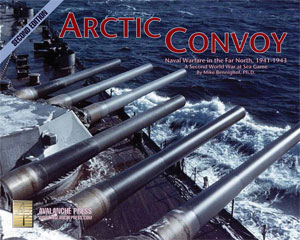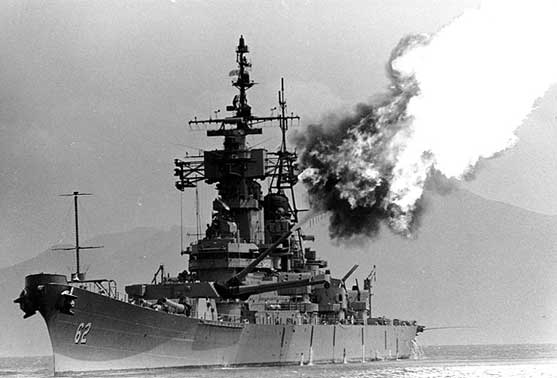| Destroyer
Killers
The
New American Battleships of World War Two, Part
2
By David Hughes
December 2018
 The big new U.S.
Navy battleships had the
most effective secondary armaments ever deployed,
for the decision was made to combine into
one system the guns that would fight attacking
bombers and closing destroyers.The Royal
Navy went the same way but with seriously
flawed guns and controls. All of the other
navies mounted two separate sets of guns
on their ships. The big new U.S.
Navy battleships had the
most effective secondary armaments ever deployed,
for the decision was made to combine into
one system the guns that would fight attacking
bombers and closing destroyers.The Royal
Navy went the same way but with seriously
flawed guns and controls. All of the other
navies mounted two separate sets of guns
on their ships.
For example, the Bismarck mounted 150mm to fight ships and 105mm to
combat bombers, the Littorio 152mm and 90mm.
Taken separately they were good guns and
systems but it meant that when firing at
a single target type they had fewer weapons
available than the American ships. It could
be argued that when under attack by both
ships and aircraft the USN concept would
prove wanting. On the other hand this would
be an unlikely event — a rare example
being when the Japanese Centre Force was
under simultaneous attack by both the planes
and destroyers of "Taffy 3" at
the battle off Samar.

Just
one purpose. 105mm anti-aircraft ammunition
aboard the battleship Tirpitz.
The key component was the much-vaunted 5-inch
38 calibre gun. What was impressive about
this weapon was that it was a compromise,
not very good at either task but perfectly
competent at both. The difficulty faced by
all navies was not in designing a gun that
could fire effectively at both high and low
elevations, but in ensuring that it could
be quickly loaded at both.
If a gun like the American 5-inch/51 had
a long barrel set so that it could be easily
loaded when firing at a destroyer, when cocked
up to shoot at a bomber its breech would
be touching the deck. Whatever one did this
resulted in a clumsy and slow rate of loading.
On the other hand a short-barrelled anti-aircraft
gun (such as the 5-inch/25) could be loaded
at any angle with the greatest of ease, but
was totally inadequate as a long range ship-killing
gun.
What the USN designed was the ultimate
compromise, with its breech height set
to achieve the maximum rate of fire in both
situations. As an example, the New Jersey managed
to pump out no less than 394 aimed rounds
in less than three minutes at the destroyer Maikaze on
February 16th, 1944.
In contrast the Royal Navy was very dissatisfied
with the 5.25-inch guns mounted in their
modern battleships. The much heavier shell
(at the upper limit of hand loading) was
the primary reason for the distinctly unsatisfactory
rate of fire — an insipid eight rounds
per minute compared with the almost 20 rounds
a good American crew could produce with their
5-inch gun. There was a good British dual-purpose
weapon, the 4.5-inch mounted in rebuilt older
battleships such as the Valiant and the new
armoured aircraft carriers. Depending on
crew quality it could match the 5-inch in
rate of fire. But it lacked the American
secret weapon. This was not the gun, but
the best secondary fire control system fitted
in any battleship. Indeed it was given the
ultimate compliment when used in the new
Royal Navy battleship Vanguard after the
war. With this size of gun, control systems
were far more important than gun or crew.
There was a famous example of this early
in the war when two crack destroyer flotillas
met in the First Battle of Narvik. Their
guns (the British 4.7-inch, the German 127-mm)
were designed just to shoot at enemy ships,
their gun crews were among the very best
in their respective navies, yet they managed
a derisory hit rate. The problem was that
the director systems were just not good enough
when faced with fast-moving ships clouded
in smoke and making abrupt changes of course.
Fascinated as we are with the size and number
of guns we often overlook this issue. Take
an example using American destroyers and
battleships. Two good destroyers (such as
the Benson class) mount the same number
(ten) of 5-inch guns on the broadside as
would the North Carolina or Iowa. However,
the effective power of the battleship guns
would be at least double, as its elaborate
fire control and advanced radar, backed up
by multiple spotters working from a much
greater elevation, meant that its rate of
hits per gun would be far higher. Even the
ability of a destroyer to violently change
direction could be countered by the much
steadier firing platform of the bigger ship.
 A
solid gunnery platform. New Jersey pounds
the Viet Cong, 1969. A
solid gunnery platform. New Jersey pounds
the Viet Cong, 1969.
Strangely, this very rate of fire proved
something of a handicap when both the 16-inch
and 5-inch were firing at the same target.
In the same engagement as mentioned above
the Iowa was firing at the light cruiser Katori at a range of about 14,500 yards,
suitable for both main and secondary guns.
She shot 46 heavy rounds but her spotters
had no idea if she was hitting the target.
The problem was the very confusing shell
splash pattern, caused by the smaller guns
firing ten times between each main salvo.
On the topic of big guns, the Iowa was
using the new 16-inch 50 calibre guns, designed
to compensate for the lack of range and attenuated
flight time mentioned in my
last Daily Content. In theory these
were immaculately impressive weapons, but
there were some troubling features that persisted
for several years. This cannot have been
a total surprise, as a comparable move by
the Royal Navy before World War One had created
difficulties. In that case the move from
the 12-inch/45 to a 50 calibre version shortened
barrel life and reduced accuracy at long
range.
Tactically, the trouble was most acute during
the initial, critical salvos and was the
result of several factors. One was that they
used light weight barrels and therefore subject
to the "cold gun" condition. For
example, two of the class were engaged in
long-range fire (about 35,000 yards) against
the destroyer Nowaki, Iowa just after all
of its guns had been deluging Katori. Although
neither ship obtained consecutive straddles Iowa did much better than New Jersey. It
was deduced that this was partly because
her guns were already warm. Also she was
firing full nine-gun broadsides. Although
the interval between shots was greater this
meant that her spotters, both human and radar,
had a much better chance of knowing if a
straddle had been obtained.
There was another, rather strange, phenomena:
The guns overshot their calculated target
spot by as much as 1,000 yards when firing
at long range. There seem to have been several
causes, the most surprising being that the
barrels were not wearing out as quickly as
predicted! The new, longer guns did have,
as could be expected, a slightly poorer dispersal
factor than the 45 calibre weapons. In this
case an unexpected problem was that their
propellant was less consistent in quality,
one not corrected until the 1980s when the
navy started to use propellant from the 45
calibre weapons. It is astonishing that it
was still around, thirty years after the
guns that could use it had gone!
Despite all these weaknesses, it must be
emphasised that these were formidable and
deadly guns, but not quite as superior to
all others as is often assumed. In the final
part of this series I will cover the protection
of these great ships and suggesting some
alternative values for their beautiful counters.
Most of the “new” information
found here comes from the very informative
and interesting magazine Warship International. Subscriptions and back copies can be obtained
at www.warship.org.
Put the "destroyer killers"
to sea in Second World War at Sea: Arctic
Convoy!
|
